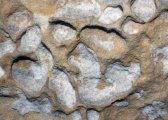What factors determine which part of the cliff will be “eaten” by salt crystals?
Numerous small pits on cliff surfaces have been noted by almost everyone who visited some of the sandstone rock cities. These pits are called honeycombs. Long ago, they were believed to form by wind erosion. For some time already, they have been understood to be shaped by a different mechanism: their origin is largely contributed by the crystallization of salts from groundwater/pore waters. A paper on this topic was released in the February issue of the Geomorphology journal: it brings additional evidence for the origin of honeycombs and, using dye experiments, documents the crucial role of the reach of hydraulic field in this process. This field, or, more exactly, its margin (i.e., the evaporation front) controls the sites of salt crystallization hence also the way the cliff surface is shaped by the salts. More information can be found in the paper, which was also contributed by scientists of the Institute of Geology: Michal Filippi as a co-author, and Jan Rohovec and Šárka Matoušková as analysts.


